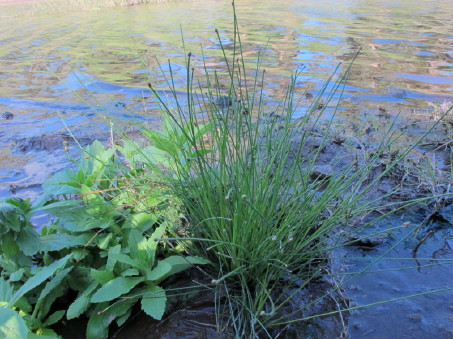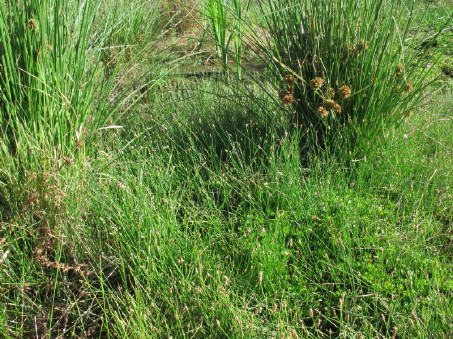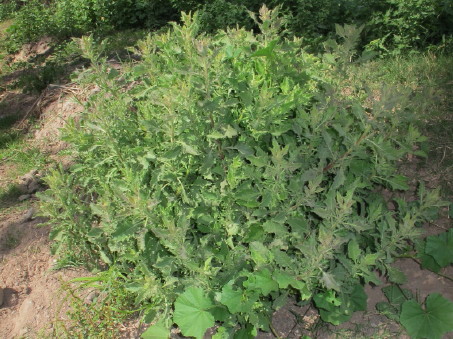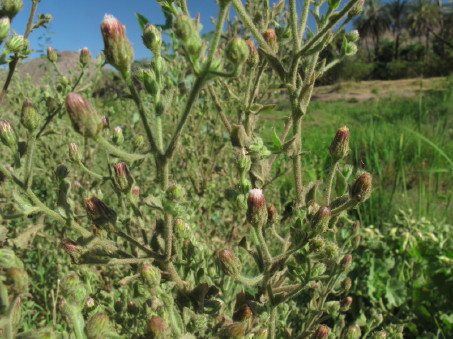This section contains entries about our botanizing in Baja California written for the UC BEE (Oct 2012 to Aug 2021)
and The UC Bee Hive (2022-), monthly newsletters for volunteers and staff of the UC Berkeley Botanical Garden.
Click on any photo for a larger image.
BEE DEC 2017
El Ojo de Agua — Mulegé Valley
Because life sometimes can throw a monkey wrench into the pursuit of botanical bliss, it's been almost 18 months since my last entry. However, while unable to spend time sharing my "discoveries" with my readers this past Spring, I was still able to get out into the field now and then, where I came across some interesting plant species in the newly forming wetland along the Mulegé River near the Ojo de Agua.
The wetland is the direct result of a dredging/canal-project-gone-wrong that ended up exposing a large portion of the subsurface water table within the palm orchard. After a major hurricane (Odile; see Jan 2015 issue) and a series of minor flash floods since then, a wealth of hydrophytic (water-loving) species have quickly infiltrated the area and it has become a lovely spot for birds, insects, and one particular botanist. See also the March 2013 and June 2015 issue for more info on the area.
El Ojo de Agua (headwater of the river) — Jan 2017
After so many years (thirteen) meticulously scouring the area around Mulegé, each season I don't expect to come across many new (to me) species to add to my inventory list. However, this Spring yielded 4 new species along the river, plus one desert perennial. I also followed the progress of a couple of introduced species that are slowly establishing themselves in a few places beyond their former domesticated gardens. Following are some photos of the area, both from previous years and this past Spring, to show how much the area has changed. You'll also find photos of individual species.
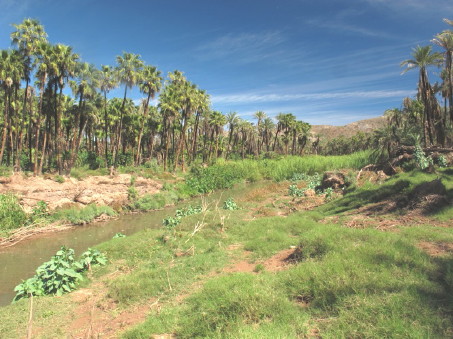
Here is the view of the upper Mulegé River (looking downstream) from Feb. 2015 a few months after they first dredged and bulldozed the Oasis.
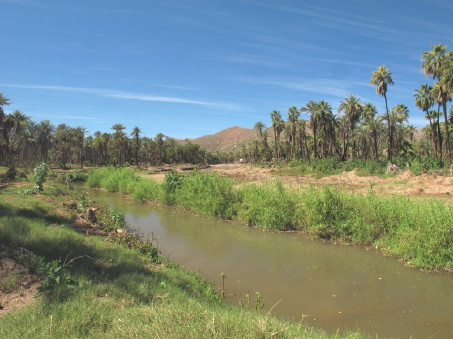
This is what upstream looked liked in January 2015, about 8 months after the clear-cutting and dredging, and four months after Hurricane Odile flooded the valley and town. The light patch in the upper middle area was razed and the water table exposed in multiple spots.
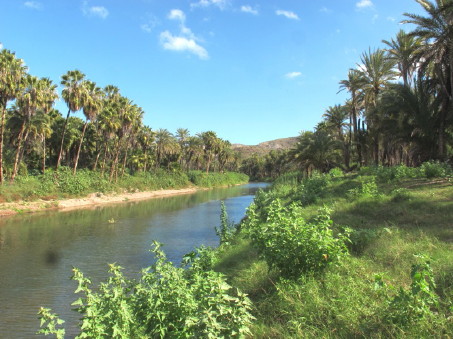
Here is the same view
in Jan 2017 after a major flood from Hurricane Odile and a couple of small flash floods. Two older images of this same spot from 2011 and 2013 can be found here.
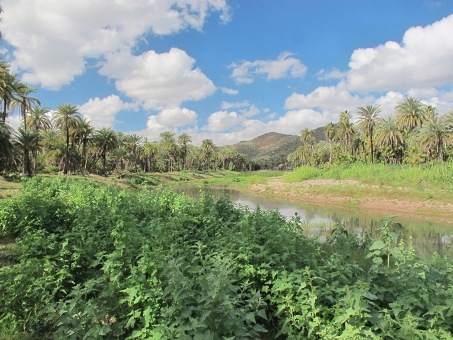
This is the same view from January 2017. The course of the river changed and widened and the bare patches are filling in with hydrophytes. You can see an older image from a nearby spot taken in May 2013 here.
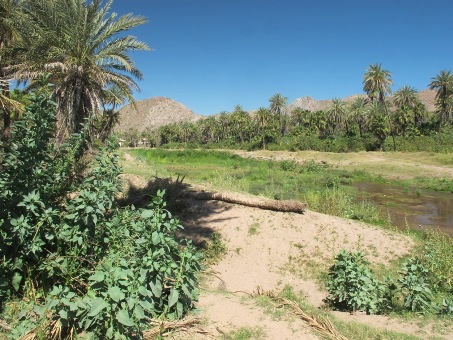
The new marsh in March 2017.
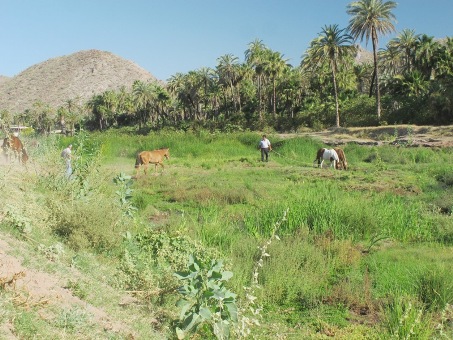
The wetland area is a favorite place for nearby residents to let their livestock graze. Here a couple of locals lead their horses down to drink.
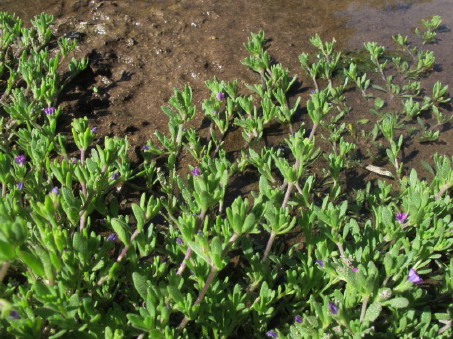
Seaside petunia or Petunia Costera (Petunia parviflora, Solanaceae).
First seen in the west ditch in Feb. 2013, this native annual was making quite a showing in the wetland. Some plants formed mats 1m or more across.
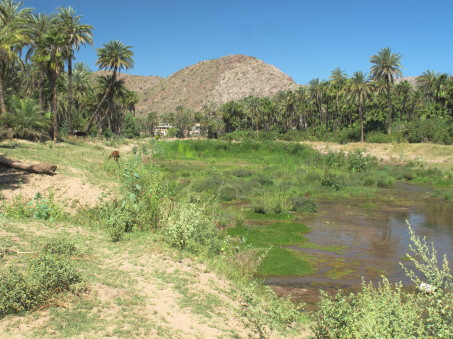
You can see an image here of this same view from March 2013.
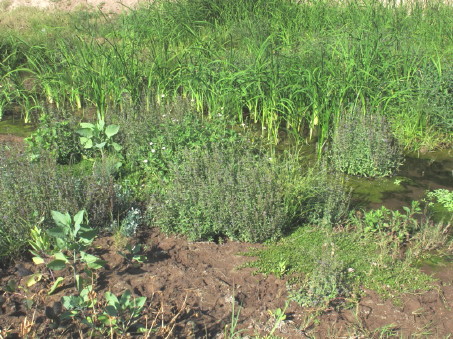
An example of the diversity and density of species that have been thriving in the wetlands. The soil varies from damp to saturated. In this image there are at least 7 species (Amauria, Bacopa, Cyperus, Heliotropium, Nicotiana, Stemodia, and Typha).
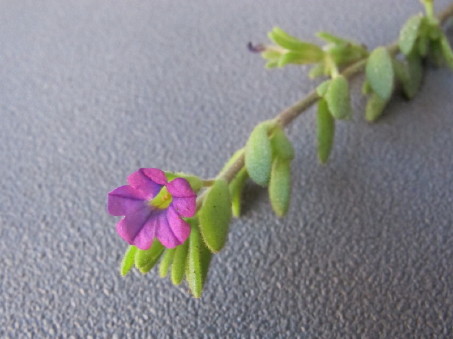
Flower of Seaside Petunia or Petunia Costera (Petunia parviflora).
My first sighting in 2012 had been of a tiny specimen, about 15 cm L x 5 cm W, and that was exciting. The flowers are about 5 mm D. The leaves are fleshy.
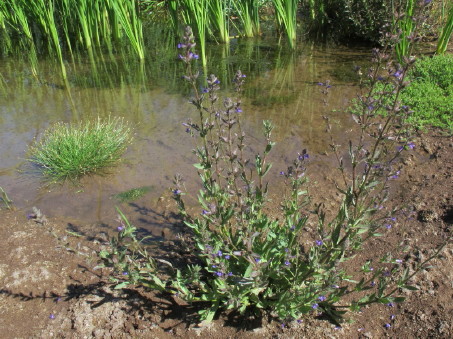
Blue Streamwort (Stemodia durantifolia var. durantifolia, Plantaginaceae) has been a common annual along the river banks for several years. Here it is widespread & abundant in the new marsh.
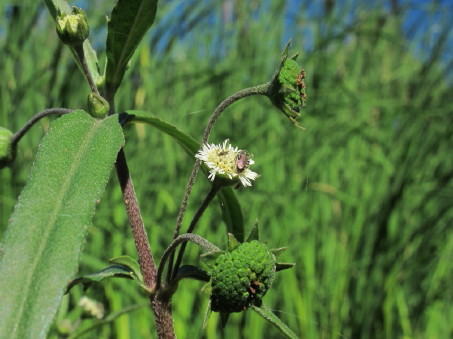
False daisy or Siemprevivilla (Eclipta prostrata, Asteraceae). Flower heads are about 1 cm D, the ray flowers are whitish yellow, and only 1.5 - 3 mm L.

Flowers of Blue Streamwort. Corollas are about 8 mm D and 8-10 mm L. The herbage is glandular. This is a wetland species that is mostly found in the southern half of the peninsula.
This is Bent Spikerush or Junquillo (Eleocharis geniculata, Cyperaceae), an annual. This is the first time I've noted it in the Mulegé River since I started botanizing here in 2007.
Parish´s Spikerush or Junquillo (Eleocharis parishii, Cyperaceae). This is the second of two species of Spikerush that are newly present along the river.
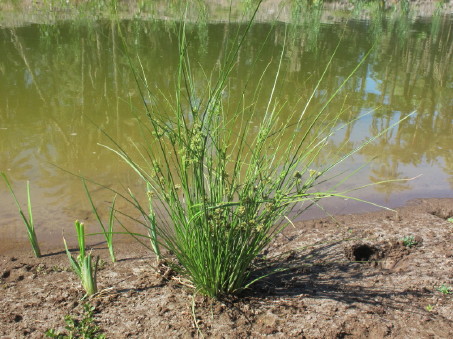
Royal Flatsedge or Junco (Cyperus elegans, Cyperaceae) is a perennial native that has done well along the Ojo and that continues to reappear after each flood or disturbance. It is a beautiful plant, reaching just over a meter when more mature. The herbage is quite tacky, and from this photo, it seems that the local domestic herbivores don´t like it. Here, they have left it alone but have eaten the young shoots of its defenseless neighbor Typha dominguensis.
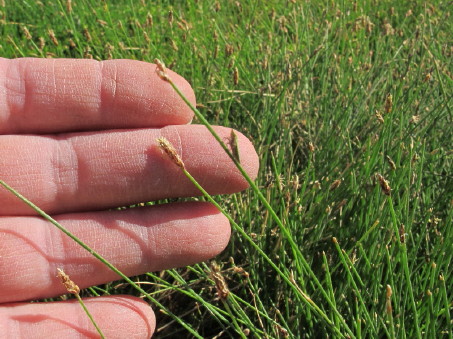
This is a perennial species, speading by rhizomes that give it a grass-like appearance. It spreads widely in dense stands. The culms are wiry like E. geniculata and up to 1 mm D.
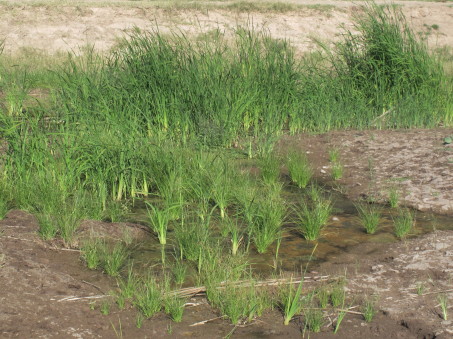
Young Southern Cattail or Tule plants (Typha dominguensis, Typhaceae). This species has done very well the last few years at the Ojo, each season becoming more widespread.
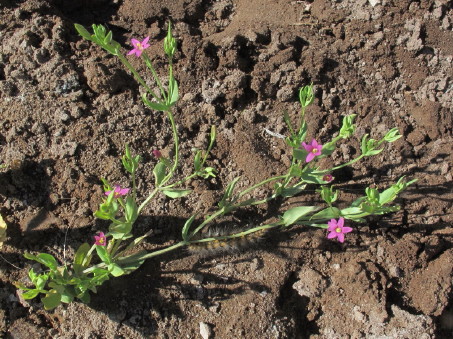
(Updated 10-Dec-18): Cape Centaury (Centaurium capense, Gentianaceae). It is an endemic annual that is known from farther south on the peninsula as well as from the mountain region to the west of Mulegé, so it makes sense to find it here, downstream in a similar environment after a flash flood.
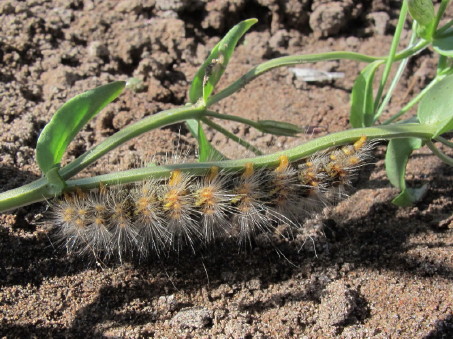
This caterpillar feeding on Centaurium capense may be the caterpillar of a Tiger Moth species such as in the genera Grammia or Estigmene. I was so focused on the tiny flowers that initially I completely missed this almost 5 cm long wooly bear hanging under the spindly stems!
Clammy False Oxtongue (Blumea viscosa, Asteraceae). This species was first observed in April 2013 and it has continued to thrive in a small population at the original site and nearby, having survived a couple of major floods.
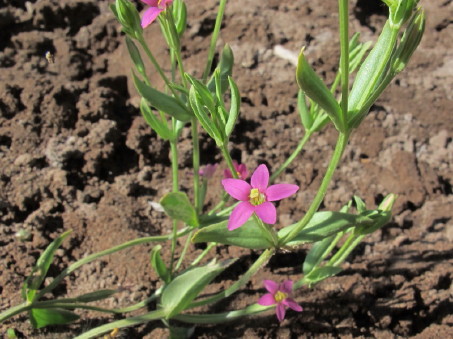
The specimen I brought to the SD Herbarium did not have mature fruit to help identify it definitively, but Jon Rebman, Curator of the Herbarium made the determination. I will look for returning plants this coming season and hope to find a more mature specimen.
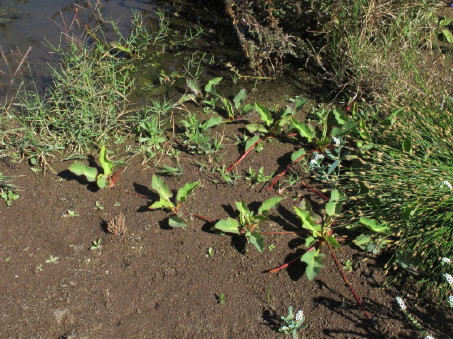
New Yerba Mansa shoots (Anemopsis californica, Saururaceae) spreading across a small pool. This perennial species appears to be tough, and even after the worst floods, there are always some small populations able to hang on and recolonize.
Blumea flowers are small, discoid, and inconspicuous. The herbage is very sticky and to me, the smell is unpleasant, like turpentine. It is an uncommon, native species (Rebman, et. al, 2016).
Beyond the Ojo de Agua
I found two other plants last season to add to my inventory that occur outside of the Ojo. One was downstream in the freshwater lagoon just before it emptied into the estuary. The other was located in desert scrub out in the Mulegé valley.
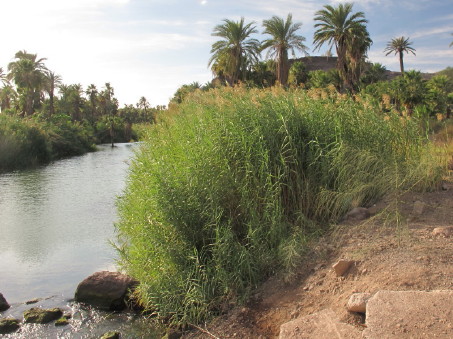
Gulf Coast Reed or Carricillo (Phragmites australis subsp. berlandieri, Poaceae) was seen downstream of the Ojo for the first time in late 2015.The species is similar in growth habit and habitat to that of Giant Reed (Arundo donax) which can be found both up and downstream.
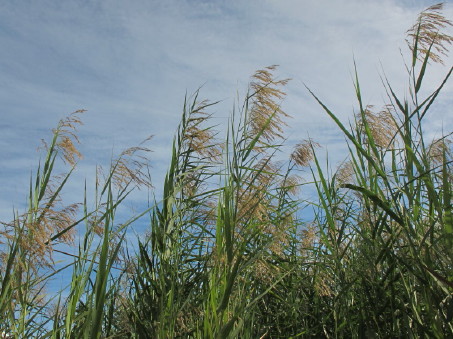
This variety is native to the peninsula and can be found in wetlands and canyons with intermittent watercourses across most of the peninsula's desert regions. You can compare here the inflorescences with those of Arundo.
Mulegé Valley — April 2017
Still early in the season, I headed out one day to the Mulegé Valley to scout out potential sites for further investigation, as well as to see what havoc the minor flood during the past summer might have caused. Stopping at a spot I´ve looked at before, I started wandering around in the brush, making phenology notes (i.e. recording which herbs and shrubs were in bloom or had fruit). At one point, I was interrupted by a small herd of cattle wandering across my path, and they were much more alarmed than I was by the sudden meeting. Cows are far more preferable to rattlesnakes, as I can atest! I waited for them to wander across the road and then turned back and stumbled upon a small population of Desert Broom-Rape or Flor de Tierra (Aphyllon [Orobanche] cooperi subsp. latilobum, Orobanchaceae) sitting out in the open on a silty mound.
I was very pleased, since it was the first time I´d seen this parasitic plant in the Mulegé area, and the first time in Baja with fresh flowers. I excitedly looked around for others and soon found a few more stems poking out of the sand here and there, and then finally a larger cluster well hidden within the the stems of a Sweetbush or Apá (Bebbia juncea, Asteraceae).
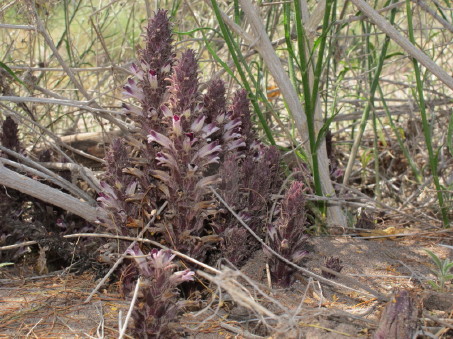
Broom-Rapes are root holoparasites, meaning they lack chlorophyll, cannot photosynthesize, and derive all nutrients by tapping into the roots of their hosts. When I found these, I didn't know the host plant, but it seemed clear it was either the Sweetbush (Bebbia juncea, Asteraceae) seen here above...
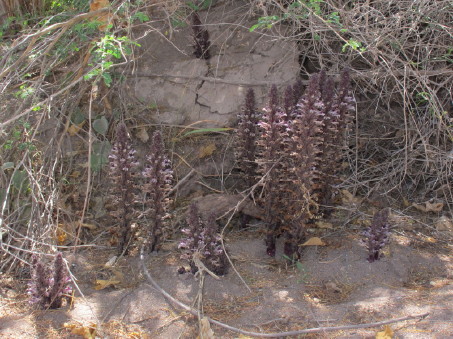
About a month later, while on another trip out to the Valley, I stopped to see if they were still around, I wasn't really hopeful that they would be given the heat and aridity we'd been having. I didn´t expect what I found. Not 10 feet away, at the base of another clump of Bebbia was a large colony blooming like crazy, most of them much larger than the previous month´s plants. Height: 15-40 cm.
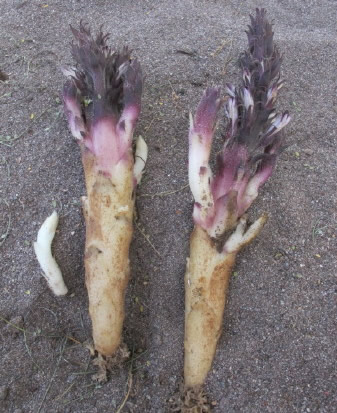 The lack of chlorophyll is evident from this photo which shows the change in color from above to below ground.
The lack of chlorophyll is evident from this photo which shows the change in color from above to below ground.
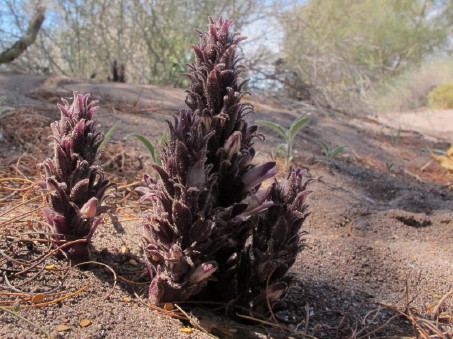
...or the roots of the leguminous Mesquite (Prosopis articulata) and/or Palo Verde (Parkinsonia microphylla), under which this and a few other clusters grew farther away from the Sweetbush. Later, I learned that this plant has a number of different hosts in the Sunflower family (Asteraceae). Height: 10 cm.
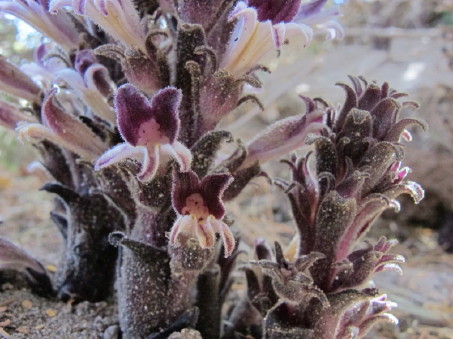
The stems are very interesting. Above ground they are mostly dark purple or slightly paler. The flowers are tubular with 5 lobes, purple and white, fleshy, densely glandular-pubescent, and about 10 mm D.
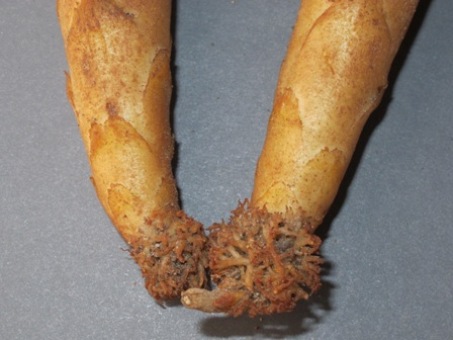
The plant is connected by what has been described as a "coral-like thickening" (Jepson eflora), as seen here. This specimen was collected for a voucher sheet.
Good news! The Annotated Checklist of the Vascular Plants of Baja California, Mexico by Rebman, Gibson and Rich (2016) is now available to download for free as a PDF. When I started to collect voucher specimens in Baja California back in 2003, I hoped that my work would some day end up contributing to the body of scientific knowledge. I'm excited because nine of my collections of introduced species are listed in the Checklist as the representative specimen for the states of BCS (8) and BC (1).
It's time to get back out into the field for the season here in Mulegé and take a look at what this summer's rain from TS Lidia brought the region. I look forward to sharing my finds with you all in the coming months. Until then, hasta la próxima…
Debra Valov—Curatorial volunteer















